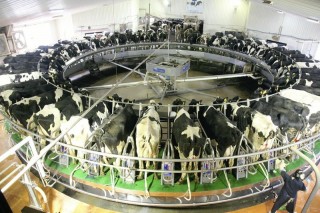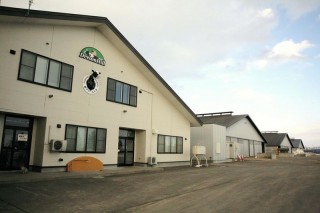Loading
Search
▼ Mega Dairy a Model For Future Agriculture
- Category:Other
By Yasuyuki Yamada / Yomiuri Shimbun Staff Writer
KAMISHIHORO, Hokkaido — Agricultural production corporation DreamHill became the first corporation or individual in Hokkaido last year to ship over 20,000 tons of milk in a single year.
Under the Trans-Pacific Partnership free trade deal, dairy farms are under pressure to shift to large-scale operations to stay in business. These cutting-edge megafarms could very well be a glimpse into the future of agriculture in Japan.
At DreamHill, based in Kamishihoro, Hokkaido, and headed by Yukio Ogura, about 50 big cows lumbered into a cowshed and made their way onto a circular platform roughly 15 meters in diameter.
KAMISHIHORO, Hokkaido — Agricultural production corporation DreamHill became the first corporation or individual in Hokkaido last year to ship over 20,000 tons of milk in a single year.
Under the Trans-Pacific Partnership free trade deal, dairy farms are under pressure to shift to large-scale operations to stay in business. These cutting-edge megafarms could very well be a glimpse into the future of agriculture in Japan.
At DreamHill, based in Kamishihoro, Hokkaido, and headed by Yukio Ogura, about 50 big cows lumbered into a cowshed and made their way onto a circular platform roughly 15 meters in diameter.
Six workers reached up from under the platform, which was raised a meter above ground, and washed the cows using brushes and sterilized them. Then they skillfully attached milkers onto the cows’ udders.
“This lets us milk the cows without bending our waists and folding our knees. This would have been unimaginable not too long ago, right?” said Masakazu Hoshi, 37.
‘160 Tokyo Domes’
DreamHill sits on a hill about 10 minutes by car northeast of the town center. From here, the last vestige of snow can be seen on the peaks of mountains in the distance.
The farm spans a vast 750 hectares, which might be difficult to picture even after being told it was “equivalent to 160 Tokyo Domes.” The farm maintains a total of 14 sheds, including eight large stall-free barns where cows can freely roam. About 2,500 cows are kept here, including breeding cows.
The circular platform is an American milking machine called a rotary milking parlor, which is not as commonly seen in Japan. The merry-go-round-like machine costs around ¥150 million, but it makes the milking process far more efficient and enables the possibility of large-scale farming.
Rotary milking parlors take about 10 minutes to make a full rotation. When a cow stops giving milk, the milker automatically detaches and falls to the platform. All of the milkers will have detached by the time the platform completes a rotation.
The cows are then guided by workers off the platform, and back to their sheds. The next group is then sent in and ushered onto the platform. Almost none of the cows moo — they steadily lumber onto the platform, climb off and then return to their cowsheds.
Cows at DreamHill are milked three times a day in the morning, daytime and evening, taking about six hours to milk all of them. The milking platform runs for almost the entire day. Cows can become sick if they are not milked regularly, so the farm even has a generator in case of blackouts from natural disasters.
About 57 tons of milk is shipped every day. A fleet of milk lorries is constantly coming and going, each with the capacity to transport 15 tons of milk, to deliver fresh milk to the factory.
Aiming for 30,000 tons
I was guided on a tour around the cowsheds by Takehiro Toshima, a 42-year-old employee assigned to breeding. The sheds were very humid and smelled of dung.
The health condition of each cow was managed using data from a device. Toshima would examine the data and check up on any cows that exhibit even slightly abnormal readings. He went around to a cow, called a veterinarian and inserted a thermometer in its rear.
“I think this is alright,” Toshima said. This is how he identifies the best times for breeding.
Workers are assigned to different responsibilities like milking, feeding, cowshed maintenance and breeding. They work in shifts, taking one day off for every four days worked. This is completely different from what one might imagine a traditional dairy farm to be like, where people spend every day of the year with the cows, day and night.
At 2 a.m., headlights could be seen at the cowsheds. Workers responsible for feeding start working at 2:30 a.m. More workers arrive by car, one by one. The morning milking session starts at 3:15 a.m.
When the cows leave their sheds for milking, workers responsible for cleaning come in and operate an excavator to remove dung and line the place with rice-hulls, which serve as mattresses for cows. This morning shift worker, who repeated this task throughout the morning, swapped places with a worker covering the afternoon shift and headed home.
“We’ll be able to compete with foreign countries by using the Hokkaido and Tokachi [region] brands and combining them with this business scale,” the president said. “Our next goal is 30,000 tons.”
■ DreamHill
Four farms teamed up to establish a limited company in 2003. It expanded by buying land from farmers who were leaving the agricultural industry. It also hired some families who left agriculture, and now has 42 employees. About 10 trainees also live in condominiums at the premises and work.
The average dairy farm in Hokkaido owns about 120 cows, and stands at about 150 cows in the Tokachi region, where the farming business is larger in scale. Even in New Zealand, a country known for its dairy industry, the average number of cows is 400. The scale of DreamHill is incomparable. The average annual production for a dairy farm in Tokachi is about 840 tons, so 20,000 tons is over 24 times that figure. At the national level, Mizuho Farm in Hitachiomiya, Ibaraki Prefecture, ships about 60,000 tons a year.
The Hokkaido farm, as the name implies, is aiming to become a “hill of dreams” and has an ice cream factory with a cafe. A second factory will be completed in May, and the operation of a second rotary milking parlor will start in October.
“This lets us milk the cows without bending our waists and folding our knees. This would have been unimaginable not too long ago, right?” said Masakazu Hoshi, 37.
‘160 Tokyo Domes’
DreamHill sits on a hill about 10 minutes by car northeast of the town center. From here, the last vestige of snow can be seen on the peaks of mountains in the distance.
The farm spans a vast 750 hectares, which might be difficult to picture even after being told it was “equivalent to 160 Tokyo Domes.” The farm maintains a total of 14 sheds, including eight large stall-free barns where cows can freely roam. About 2,500 cows are kept here, including breeding cows.
The circular platform is an American milking machine called a rotary milking parlor, which is not as commonly seen in Japan. The merry-go-round-like machine costs around ¥150 million, but it makes the milking process far more efficient and enables the possibility of large-scale farming.
Rotary milking parlors take about 10 minutes to make a full rotation. When a cow stops giving milk, the milker automatically detaches and falls to the platform. All of the milkers will have detached by the time the platform completes a rotation.
The cows are then guided by workers off the platform, and back to their sheds. The next group is then sent in and ushered onto the platform. Almost none of the cows moo — they steadily lumber onto the platform, climb off and then return to their cowsheds.
Cows at DreamHill are milked three times a day in the morning, daytime and evening, taking about six hours to milk all of them. The milking platform runs for almost the entire day. Cows can become sick if they are not milked regularly, so the farm even has a generator in case of blackouts from natural disasters.
About 57 tons of milk is shipped every day. A fleet of milk lorries is constantly coming and going, each with the capacity to transport 15 tons of milk, to deliver fresh milk to the factory.
Aiming for 30,000 tons
I was guided on a tour around the cowsheds by Takehiro Toshima, a 42-year-old employee assigned to breeding. The sheds were very humid and smelled of dung.
The health condition of each cow was managed using data from a device. Toshima would examine the data and check up on any cows that exhibit even slightly abnormal readings. He went around to a cow, called a veterinarian and inserted a thermometer in its rear.
“I think this is alright,” Toshima said. This is how he identifies the best times for breeding.
Workers are assigned to different responsibilities like milking, feeding, cowshed maintenance and breeding. They work in shifts, taking one day off for every four days worked. This is completely different from what one might imagine a traditional dairy farm to be like, where people spend every day of the year with the cows, day and night.
At 2 a.m., headlights could be seen at the cowsheds. Workers responsible for feeding start working at 2:30 a.m. More workers arrive by car, one by one. The morning milking session starts at 3:15 a.m.
When the cows leave their sheds for milking, workers responsible for cleaning come in and operate an excavator to remove dung and line the place with rice-hulls, which serve as mattresses for cows. This morning shift worker, who repeated this task throughout the morning, swapped places with a worker covering the afternoon shift and headed home.
“We’ll be able to compete with foreign countries by using the Hokkaido and Tokachi [region] brands and combining them with this business scale,” the president said. “Our next goal is 30,000 tons.”
■ DreamHill
Four farms teamed up to establish a limited company in 2003. It expanded by buying land from farmers who were leaving the agricultural industry. It also hired some families who left agriculture, and now has 42 employees. About 10 trainees also live in condominiums at the premises and work.
The average dairy farm in Hokkaido owns about 120 cows, and stands at about 150 cows in the Tokachi region, where the farming business is larger in scale. Even in New Zealand, a country known for its dairy industry, the average number of cows is 400. The scale of DreamHill is incomparable. The average annual production for a dairy farm in Tokachi is about 840 tons, so 20,000 tons is over 24 times that figure. At the national level, Mizuho Farm in Hitachiomiya, Ibaraki Prefecture, ships about 60,000 tons a year.
The Hokkaido farm, as the name implies, is aiming to become a “hill of dreams” and has an ice cream factory with a cafe. A second factory will be completed in May, and the operation of a second rotary milking parlor will start in October.
- May 9, 2016
- Comment (0)
- Trackback(0)



